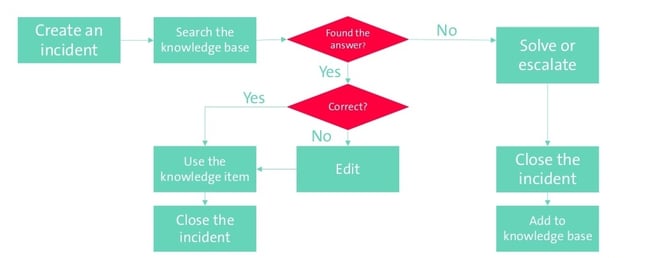
Hannah Price
Consultant and knowledge sharing enthusiast
If you're looking for a way to decrease the amount of time spent on recurring calls, investing in Knowledge Management is a great strategy. At a modern service desk, employees resolve calls using a collective knowledge base. Instead of constantly reinventing the wheel to close similar incidents, they help customers in a way that is smart and efficient.
Why is Knowledge Management important?
At TOPdesk, we cut resolution times by 25% when we implemented Knowledge Management best practices. Our best practices are all about utilizing a Knowledge Base to its full extent. It is a great asset for many reasons. Not only can your team access the information they need to solve calls quicker, but you can also motivate a service desk culture based on sharing knowledge and working together, which massively helps team spirit and allows for more fun at work.
These are the benefits of knowledge management
What is a Knowledge Base?
A Knowledge Base is essentially exactly what it sounds like: a place where your very capable service desk’s collective knowledge lives, neatly organized into targeted articles. You can use knowledge items to quickly solve calls without asking a teammate for help, or even to publish to your users so they can solve simple issues themselves. You may know this as Shift Left.

This here is a knowledge management best practice process flow. As you can see, there are two different paths you can follow here. We can call it the short arm and the long arm. In the short arm, you find help with solving your issue in the Knowledge Base, and you can take a nice, easy shortcut. However, to get to a point where you can use the shortcut every time, you need to go through the long arm a couple of times first – and you do this by following these Best Practice steps:
1. Search the Knowledge Base first
Always, always, always search the knowledge base first, even if you know the answer. First of all, it saves you time typing out a response. But secondly, if it is not there, you now know you need to add it, or edit the topic.
But assume an incident is logged and you need to deal with it, but you don’t know the answer. The first place to go to should be the knowledge base. Maybe this problem has been encountered and solved before? In that case, you can easily just copy and paste the solution and close the ticket, or follow a step-by-step. If not, make a note to add an item (however brief) once you solve the call.
2. Correct the Knowledge Base
If you find that the knowledge item is lacking something, make sure you fix it straight away. This way, your knowledge base becomes a continuously updated hub for all knowledge in the Service Desk. Maybe you are using a quicker solution than is already posted. Why not help your team members by adding this solution?
3. Solve the call
Now, potentially armed with some new knowledge, you are ready to solve the call. While doing so, keep an eye and an ear open for anything in the solution process that deviates from what was stated in the knowledge item.
4. Closing the incident
You fixed the incident and can now confidentially close the call. Once you do, see if you can add to the answer in the knowledge base. Maybe you need to fix a typo, or the solution needs an update, or the article could do with a screenshot for extra clarification. Even small changes could be helpful.
Just remember that knowledge management is a continuous process. If you are just implementing it, then you are going to have to go down the ‘long arm’ a lot of the times at the start. But as more and more solutions are added, the whole team can take shortcuts to solve incidents quicker by going down the ‘short arm’ more often. Think of it like physiotherapy! You need to work hard with some tough exercises at first, but the long term benefits are infinite.
Share knowledge better in your organization
Want more inspiration on sharing knowledge? Download our Knowledge Management e-book for tips and tricks and a way to calculate your time and cost savings.


Submit a Comment